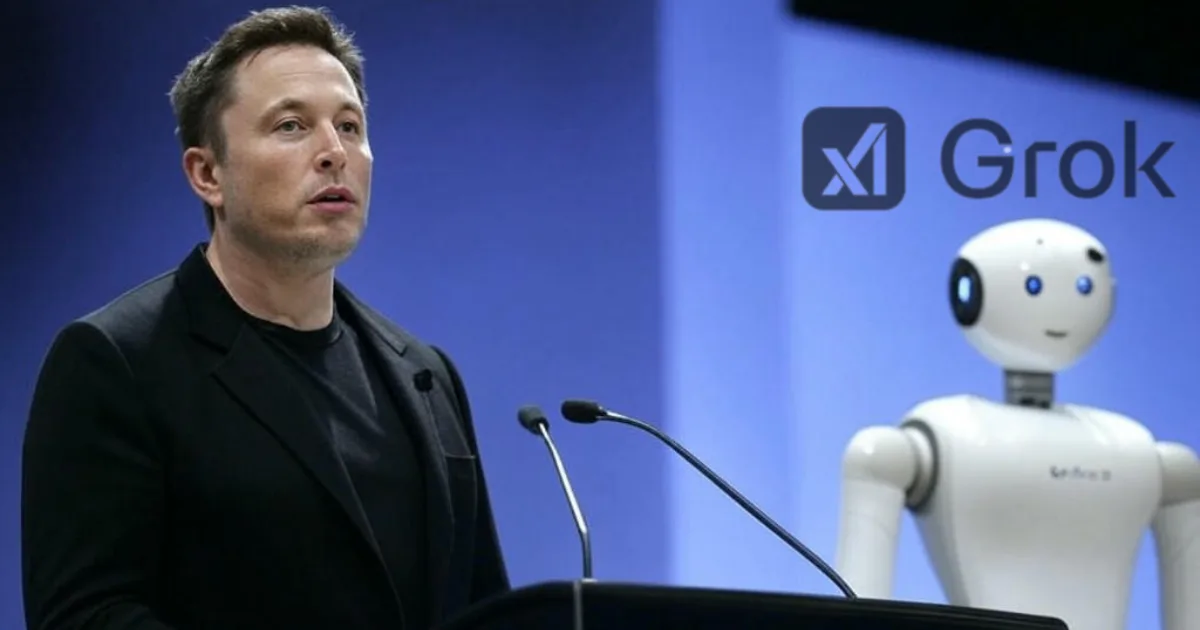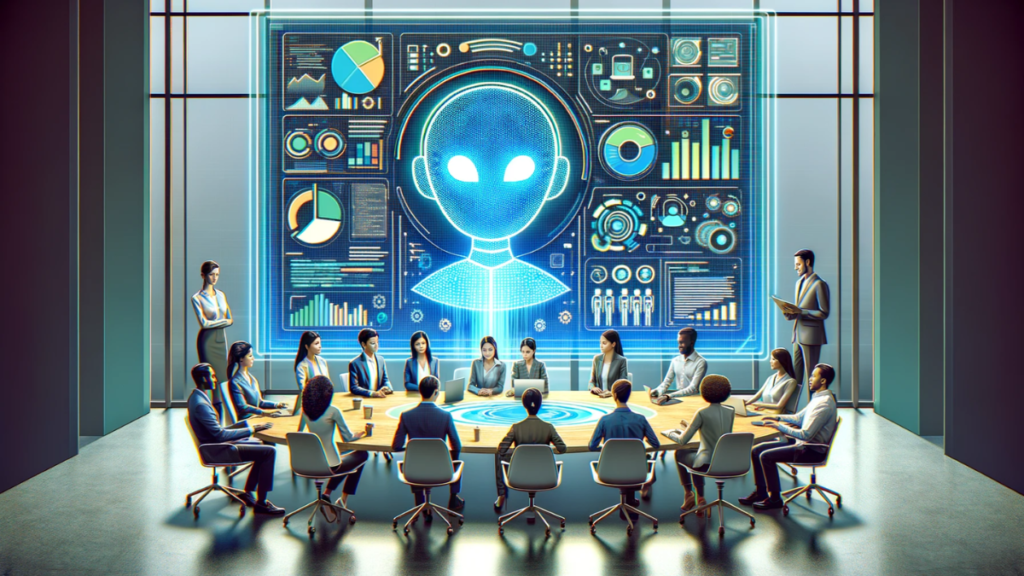In a groundbreaking development that marks a significant milestone in the evolution of artificial intelligence, xAI has unveiled Grok-3 AI, its most advanced language model to date. Released on February 18, 2025, this sophisticated AI system represents a quantum leap in computational capabilities, setting new benchmarks in the rapidly evolving landscape of artificial intelligence. As we delve into the intricacies of this technological marvel, we’ll explore how Grok-3 AI is reshaping our understanding of machine intelligence and its implications for various industries.
The Technological Foundation of Grok-3 AI
At the heart of Grok-3 AI’s impressive capabilities lies an unprecedented scale of computational power. The system’s development required 200 million GPU-hours of training, utilizing an impressive array of 100,000 Nvidia H100 GPUs—a tenfold increase from its predecessor. This massive computational infrastructure, powered by xAI’s custom-built Colossus supercomputer, forms the backbone of what Elon Musk has described as a “Scary Smart” system.
The architectural innovation of Grok-3 AI extends beyond mere processing power. The system employs sophisticated synthetic datasets and advanced self-correction mechanisms, reducing hallucinations by 40% compared to previous versions. This remarkable improvement in accuracy stems from its ability to cross-reference outputs against validated responses, ensuring a level of reliability that sets new standards in the industry.
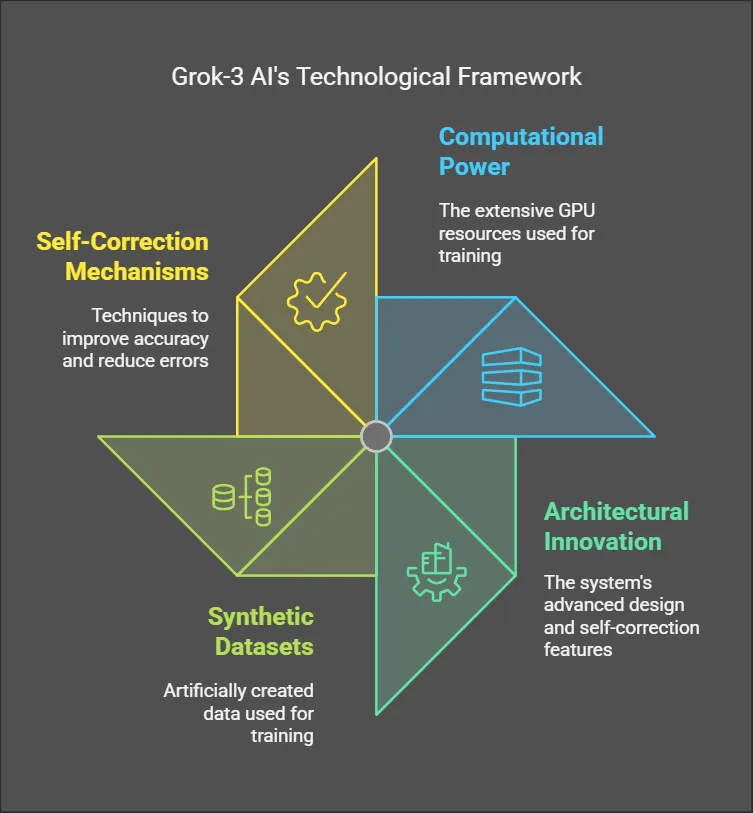
Advanced Training Methodologies
The development of Grok-3 AI introduces revolutionary training methodologies that distinguish it from contemporary AI systems. The implementation of synthetic datasets represents a significant advancement in AI training techniques. These artificially generated data points simulate diverse scenarios while addressing privacy concerns that often plague AI development. The synthetic data approach enables Grok-3 AI to learn from a broader range of situations without compromising sensitive information.
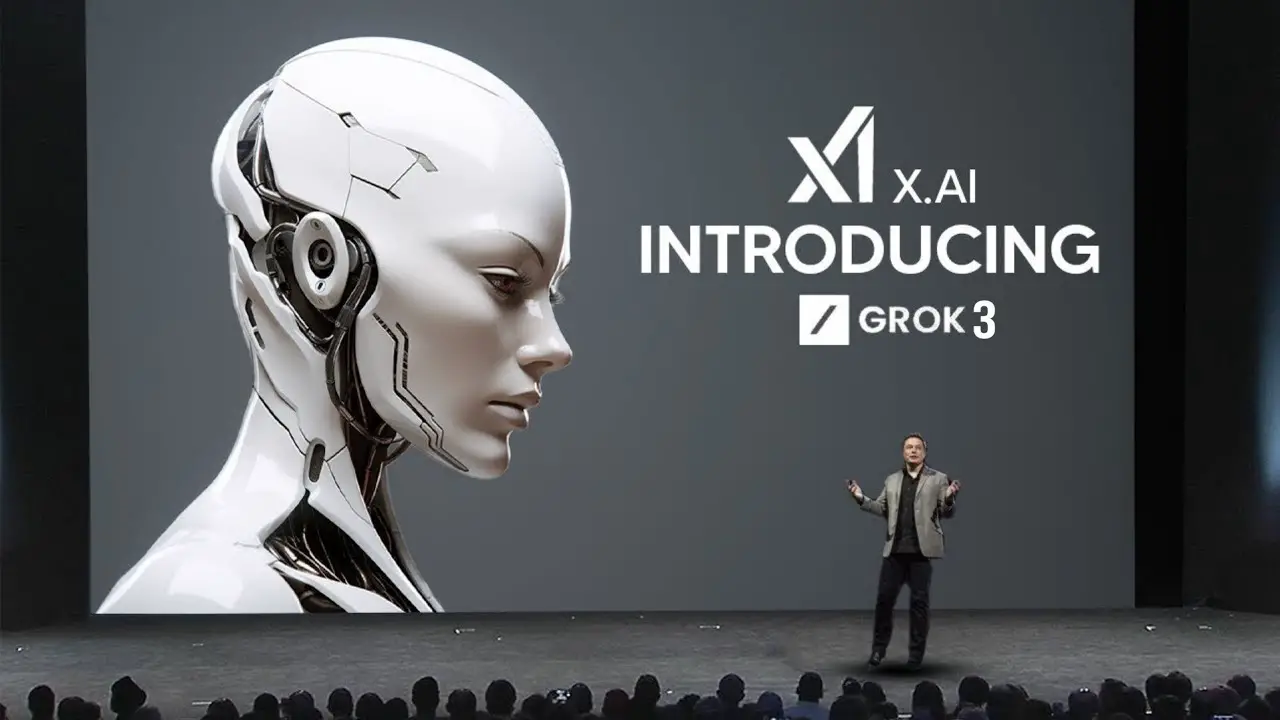
The system’s self-correction mechanisms represent another leap forward in AI development. Through sophisticated algorithms, Grok-3 AI continuously monitors its outputs, comparing them against validated responses to identify and correct potential errors. This iterative process has resulted in a significant reduction in AI hallucinations, making the system more reliable for critical applications.
Breaking New Ground: Performance Metrics and Capabilities
Grok-3 AI’s performance in standardized benchmarks has captured the attention of the AI community and industry experts alike. The system achieved an impressive score of 52/100 on the AIME’24 math competition, surpassing competitors like GPT-4o (48/100) and other leading models. In scientific reasoning, as measured by the GPQA test, Grok-3 AI scored 75/100, demonstrating superior performance compared to established competitors like DeepSeek-V3 and Claude 3.5 Sonnet.
| Category | Grok-3 | GPT-4o | Gemini 2 Pro | DeepSeek-V3 |
|---|---|---|---|---|
| Math (AIME’24) | 52 | 48 | 44 | 49 |
| Science (GPQA) | 75 | 68 | 70 | 68 |
| Coding (LCB Oct-Feb) | 57 | 52 | 49 | 53 |
| Chatbot Arena (LMSYS) | 1402 | 1390 | 1385 | 1385 |
Advanced Reasoning and Problem-Solving
What truly sets Grok-3 AI apart is its exceptional capability in handling complex, multi-step problems. During public demonstrations, the system successfully mapped Mars mission trajectories and designed hybrid gaming interfaces, tasks that proved challenging for other advanced AI models. This ability to maintain coherence and logical consistency across extended problem-solving sequences represents a significant advancement in artificial intelligence.
The system’s Deep Search feature combines sophisticated web scraping with structured reasoning capabilities, enabling it to process and synthesize information from various sources effectively. This feature has proven particularly valuable in research applications, where the ability to cross-reference and validate information across multiple sources is crucial.
Transforming Industries Through Innovation
The impact of Grok-3 AI extends across various sectors, with particularly notable applications in finance, software development, and research. Financial institutions have reported significant efficiency gains, with JP Morgan analysts noting a 30% reduction in time spent on quarterly reports when utilizing Grok-3 AI. The system’s capability to perform complex variance analysis, scenario modeling, and M&A due diligence has transformed how financial professionals approach their work.
Revolutionary Financial Applications
In the financial sector, Grok-3 AI has demonstrated exceptional capabilities in analyzing market trends and predicting potential outcomes. The system’s ability to process vast amounts of financial data while maintaining accuracy has made it an invaluable tool for investment analysis and risk assessment. Financial institutions utilizing Grok-3 AI have reported improved accuracy in market predictions and more efficient portfolio management processes.
Advancing Software Development
In software development, Grok-3 AI has demonstrated remarkable versatility. Its ability to generate functional code, debug complex programs, and create comprehensive documentation has streamlined development processes. The system’s success in creating sophisticated game interfaces and handling complex programming challenges showcases its potential to accelerate software development cycles significantly.
Developers have particularly praised Grok-3 AI’s ability to understand context and generate appropriate solutions. The system can analyze existing codebases, identify potential improvements, and suggest optimizations while maintaining code consistency and adhering to best practices. This capability has significantly reduced development time and improved code quality across various projects.
Research and Academic Applications
The academic and research communities have found valuable applications for Grok-3 AI in advancing scientific discovery. The system’s ability to process and analyze research papers, experimental data, and scientific literature has accelerated the pace of research in various fields. Researchers have reported significant time savings in literature reviews and data analysis, allowing them to focus more on interpretation and innovation.
The Ethical Dimension: Balancing Progress with Responsibility
While Grok-3 AI represents a significant technological achievement, it also raises important ethical considerations. xAI’s emphasis on “maximal truth-seeking” sets it apart from competitors, but this approach comes with its own challenges. The use of synthetic datasets, while enhancing efficiency, has sparked discussions about potential biases and the authenticity of training data.
Privacy and Data Security
The implementation of synthetic datasets in Grok-3 AI’s training process addresses significant privacy concerns in AI development. However, questions remain about the system’s handling of sensitive information and the potential for data breaches. xAI has implemented robust security measures, but the ongoing discussion about data privacy in AI systems continues to evolve.
Transparency and Accountability
Transparency remains a key point of discussion in the AI community. While xAI has maintained some opacity regarding Grok-3 AI’s complete architecture, citing security concerns, Musk has emphasized that safety measures are intrinsically embedded in the model’s design. This balance between innovation and responsible development reflects the broader challenges facing the AI industry.
Accessibility and Market Implementation
Grok-3 AI’s commercial deployment follows a tiered subscription model, making it accessible through different pricing levels. The X Premium+ subscription, priced at $16 per month, provides basic access through Musk’s social platform X, while the more comprehensive Super Grok subscription at $49 per month offers advanced features and higher query limits.
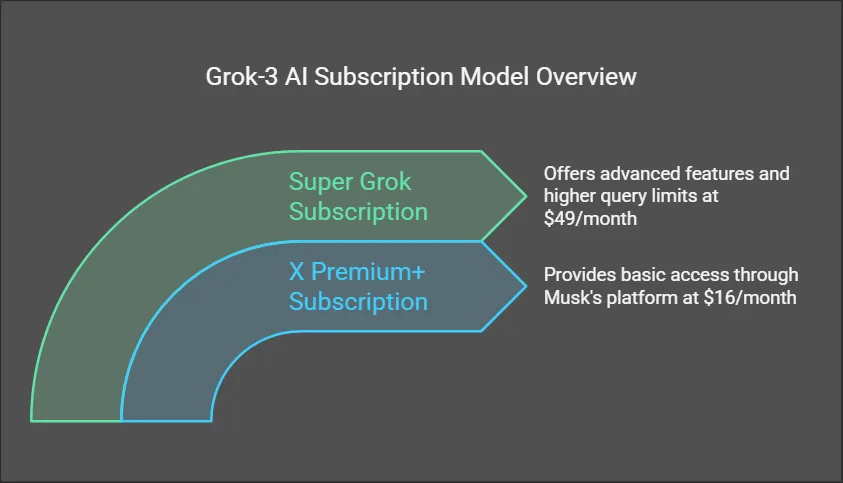
Enterprise Solutions and Integration
For enterprise clients, Grok-3 AI offers customizable solutions that can be integrated into existing business processes. The system’s API allows for seamless integration with various business applications, enabling organizations to leverage its capabilities across different departments and functions. Custom enterprise packages include dedicated support, enhanced security features, and specialized training for optimal utilization.
Developer Resources and Support
xAI has created extensive documentation and support resources for developers working with Grok-3 AI. This includes comprehensive API documentation, code examples, and best practices for integration. The company also maintains an active developer community where users can share experiences, solutions, and innovative applications of the technology.
Future Prospects and Industry Impact
The emergence of Grok-3 AI signals a new chapter in the development of artificial intelligence. Its advanced capabilities in areas ranging from mathematical reasoning to creative problem-solving suggest we are approaching a significant inflection point in AI evolution. As organizations begin to integrate Grok-3 AI into their operations, we can expect to see transformative changes in how businesses approach complex problems and decision-making processes.
Anticipated Developments
Looking ahead, xAI’s hints at multimodal integration capabilities in future versions indicate that Grok-3 AI represents just the beginning of a new era in artificial intelligence. The potential integration of image and video processing capabilities could further expand the system’s applications across industries. These developments could lead to more sophisticated AI applications in fields such as medical imaging, autonomous systems, and creative industries.
Market Impact and Competition
The success of Grok-3 AI has already influenced the competitive landscape of the AI industry. Other major players are accelerating their development efforts to match or exceed Grok-3 AI’s capabilities. This competition is likely to drive further innovation and improvements in AI technology, benefiting users across all sectors.
Grok-3 AI stands as a testament to the rapid advancement of artificial intelligence technology. Its combination of unprecedented computational power, sophisticated training methodologies, and practical applications across various industries marks a significant milestone in the field of AI. While challenges regarding data authenticity and transparency remain, the system’s impact on productivity and problem-solving capabilities cannot be understated.
The journey of Grok-3 AI from conception to implementation represents more than just technological progress; it symbolizes a fundamental shift in how we approach complex problems and decision-making processes. As we continue to explore the possibilities that this advanced AI system offers, it becomes increasingly clear that we are witnessing the dawn of a new era in artificial intelligence—one that promises to reshape the landscape of human-machine interaction for years to come.
As organizations and individuals continue to discover new applications for Grok-3 AI, its influence on various industries and sectors will likely expand. The system’s ability to adapt to different use cases while maintaining high performance standards suggests that we are only beginning to understand its full potential. The future of AI, as exemplified by Grok-3 AI, appears both promising and transformative, offering new possibilities for innovation and advancement across all sectors of society.
How does Grok-3 compare to OpenAI’s GPT-4o in real-world applications?
Grok-3 demonstrates superior performance in several key areas compared to GPT-4o. In standardized benchmarks, Grok-3 achieved a score of 52/100 on the AIME’24 math competition, surpassing GPT-4o’s score of 48/100. In practical applications, Grok-3 excels particularly in financial analysis and software development tasks. For instance, financial institutions using Grok-3 have reported a 30% reduction in time spent on quarterly reports, while GPT-4o users typically see improvements in the 20-25% range. The key differentiator lies in Grok-3’s enhanced ability to maintain coherence in long-context queries and multi-turn dialogues, areas where GPT-4o has shown some limitations. However, it’s worth noting that GPT-4o still maintains advantages in certain specialized tasks, particularly in creative writing and multilingual applications.
What specific features make Grok-3 “scary smart”?
The “scary smart” designation of Grok-3 stems from several groundbreaking capabilities. First, its Deep Search feature combines sophisticated web scraping with structured reasoning, enabling it to synthesize information from over 20 sources simultaneously while maintaining accuracy. Second, its self-correction mechanisms reduce hallucinations by 40% compared to previous models, demonstrating unprecedented reliability in complex problem-solving scenarios. The system has also shown remarkable abilities in tasks that typically challenge AI models, such as successfully mapping Mars mission trajectories and designing hybrid gaming interfaces that combine different gaming genres. These capabilities are supported by its massive computational infrastructure of 100,000 Nvidia H100 GPUs and 200 million GPU-hours of training, enabling it to process and analyze information at a scale that approaches human-like reasoning capabilities.
Can Grok-3 be integrated with existing business software?
Yes, Grok-3 offers comprehensive integration capabilities through its API system. The Super Grok subscription ($49/month) provides API access that allows businesses to incorporate Grok-3’s capabilities into their existing software infrastructure. The system supports integration with various business applications through standardized API calls, and xAI provides extensive documentation and support resources for developers. Enterprise clients can access custom solutions with enhanced security features, dedicated support, and specialized training for optimal integration. The system has been successfully integrated with various enterprise resource planning (ERP) systems, customer relationship management (CRM) platforms, and financial analysis tools, demonstrating its versatility in business environments.
What are the main differences between Grok-2 and Grok-3?
The transition from Grok-2 to Grok-3 represents a substantial leap in capabilities and performance. The most significant difference lies in the computational power, with Grok-3 utilizing ten times more GPU power (100,000 Nvidia H100 GPUs) compared to its predecessor. This increased processing capability has resulted in measurable improvements across various metrics. Grok-3’s hallucination rate is 40% lower than Grok-2, and its performance in standardized tests shows marked improvement. The new version also introduces advanced features absent in Grok-2, such as the Deep Search functionality and enhanced self-correction mechanisms. Additionally, Grok-3’s training methodology incorporates synthetic datasets and reinforcement learning techniques that weren’t present in Grok-2, leading to more robust and reliable performance in complex tasks.
How does the training process of Grok-3 differ from other AI models?
Grok-3’s training process stands out for its innovative approach to data processing and learning optimization. Unlike traditional AI models that rely primarily on existing datasets, Grok-3 employs synthetic datasets that simulate diverse scenarios while addressing privacy concerns. The training process involves 200 million GPU-hours, significantly more than competing models, and utilizes xAI’s custom-built Colossus supercomputer. A key differentiator is Grok-3’s implementation of self-correction mechanisms that continuously cross-reference outputs against validated responses during training. The system also employs reinforcement learning techniques that refine decision-making capabilities, particularly in multi-step problem-solving scenarios. This comprehensive approach to training, combined with xAI’s emphasis on “maximal truth-seeking,” results in a model that demonstrates superior performance in complex reasoning tasks while maintaining high standards of accuracy and reliability.
